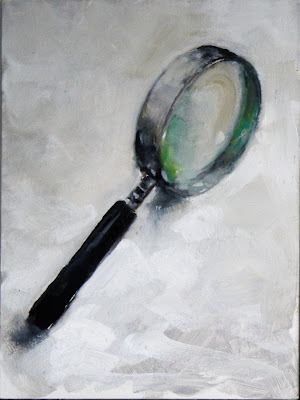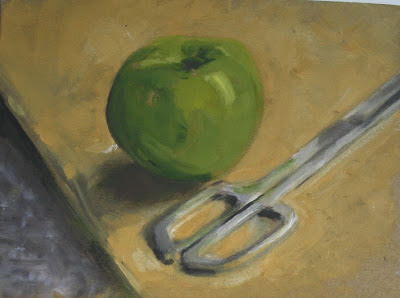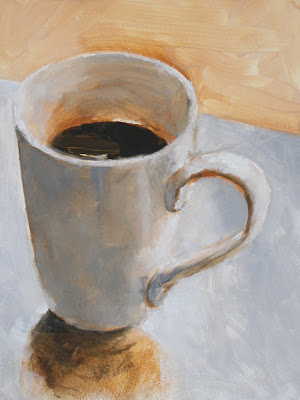One of the best ideas I've been heard is actually a slogan used by a footwear manufacturer: "Just do it." Don't think, just do. For an artist, it's a powerful piece of advice, since most of us go through dry spells when ideas and work seem sparse. And if you're like me, then you rack your brain for ideas, and too often they just don't come. There's a need to keep up the momentum of work, whether drawing or painting or whatever. Writers use the strategy of stopping their piece while knowing where the story is headed so they can start seamlessly tomorrow. Depending, painters and other artists also benefit from knowing what goes into the next segment of a work or layer or what part of the painting to finish next, and so on. But when I run a little dry--no work in progress, ideas not coming--it can be helpful to simply do a sketch of anything, whatever is at hand. Small paint sketches encourage daily discipline, careful observation, and quick and accurate paint handling. And since the work is a sketch, you don't have that much of an emotional investment. If the finished piece is attractive, wonderful. If it isn't, you've learned something not to do. And overall, sketching keeps the juices flowing.
 |
| Magnifier, oil, 6x8 |
For a long while I did a small daily oil sketch, adding each to a group I call
Windowsill Works because the object of interest was generally perched on a windowsill in the studio. All were 6x8 or smaller, so they could be finished in a single pass--alla prima.
This is a magnifying glass I've had for years and use in the studio to study detail. It was important to me to capture the greenish look of the thicker parts of the lens. When you look at most glass you can see that green tint. It comes from the iron impurities in sand that went into it. This on a hardboard panel prepped with gesso. I gave it an initial coat of gray, then painted the glass with a muted palette in around an hour. This is a 5 inch magnifying lens.
 |
| Table top, oil, 6x8 |
Sometimes instead of the windowsill I just used the top of my work table, which is covered with a piece of brown butcher paper. Here, I grabbed one of my small panels and painted these two objects. The scissors made a nice contrast to the ochre of the paper. Again, this is on a 6x8 gessoed hardboard panel, and took perhaps 45 minutes.
 |
| Morning Joe, oil, 6x8 |
And last, here is a picture of my morning coffee cup, partly full. The fun here was to try to capture the uplift of morning--energy, optimism, warmth--using the coffee as metaphor. The palette was mostly mixed grays and dark warm burnt umber with added burnt sienna. The surface is actually a sheet of glass.
As a way to keep working when the doldrums hit, as a way to keep the creative juices flowing, doing a small sketch every morning works for me. Although I admit that sometimes I do digital sketching (quick, clean, no fuss), and other times I draw with graphite or charcoal, oil sketching in the morning is a great warmup ritual.
---
Previous posts on this topic
Windowsill Works
Windowsill Works 2
Windowsill Works 3
Windowsill Works 4











